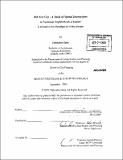Old new city : a study of spatial interactions in traditional neighborhoods of Kolkata to identify a new paradigm for urban design
Author(s)
Guha, Debmalya
DownloadFull printable version (47.97Mb)
Alternative title
Study of spatial interactions in traditional neighborhoods of Kolkata to identify a new paradigm for urban design
Other Contributors
Massachusetts Institute of Technology. Dept. of Urban Studies and Planning.
Advisor
James Wescoat.
Terms of use
Metadata
Show full item recordAbstract
This thesis through study and analyses endeavored to demonstrate how various interactions in the urban fabric of old neighborhoods of Kolkata made them more humane, inclusive and ecologically less harmful. It highlighted how these interactions of urban elements and activities of old neighborhoods have the potential to benefit new urban developments. And it calls for modem designers to study and realize the great potential of this new design paradigm which is based on increasing interactions in the urban fabric. Three different neighborhoods from Kolkata were selected, which provided a comprehensive sample of traditional urban fabric of the city. It was found that in many cases the observed conditions were in contradiction to the principles of the modem urban design. And in some cases certain aspects were observed that are completely ignored or overlooked by modem designers. After subsequent analyses it was inferred that there is one fundamental difference between old and new cites. The modem approach is to segregate different elements and activities, while in old cities these interacted with each other and created the livable conditions. The study focused on various interactions of the urban elements in the neighborhoods and grouped them into four categories: 1. Nature and urban elements 2. Built and unbuilt spaces 3. Transportation modes 4. Residential and commercial activities It was observed that these interactions encouraged and facilitated the following positive qualities in the neighborhoods. (cont.) 1. promote accessibility for all 2. encourage pedestrian movement 3. reduce private motor vehicles 4. reduce fuel consumption 5. reduce pollution 6. increase social interaction 7. create more pleasing environment 8. create employments 9. sustain local economy 10. maintain ecological balance 11. create equity and inclusiveness The thesis concludes by demonstrating the potentials of the interactive urban fabric of the old neighborhoods. And calls for a process of applying creative design solutions that embody these positive aspects in developing new cities.
Description
Thesis (M.C.P.)--Massachusetts Institute of Technology, Dept. of Urban Studies and Planning, 2009. Cataloged from PDF version of thesis. Includes bibliographical references (p. 203-206).
Date issued
2009Department
Massachusetts Institute of Technology. Department of Urban Studies and PlanningPublisher
Massachusetts Institute of Technology
Keywords
Urban Studies and Planning.